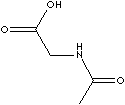PRODUCT IDENTIFICATION

H.S. CODE
TOXICITY
CLASSIFICATION
PHYSICAL AND CHEMICAL PROPERTIES
AUTOIGNITION
NFPA RATINGS
REFRACTIVE INDEX
Stable under ordinary conditions
APPLICATIONS
APPEARANCE
white powder
CONTENT
98.0 - 101.5%
ASH
0.5% max
GENERAL PROPERTIES OF GLYCINE
Glycine is a white, crystalline amino acid; dissolve in water and. As also known as aminoacetic acid, it is the simplest amino acid. It has acid group as well as amino group which both groups act as base. It is not optically active, i.e., it does not have d- and l-stereoisomers as two hydrogens are bonded to the central carbon atom. It is nonessential amino acids for mammals; i.e., they can synthesize it from amino acids serine and threonine and from other sources and do not require dietary sources. It is commercially synthesis from ammonia. It is also prepared from bromoethanoic acid by reaction with potassium phthalimide. It helps to improve glycogen storage utilized in the synthesis of hemoglobin, collagen, and glutathione, and facilitates the amelioration of high blood fat and uric acid levels.